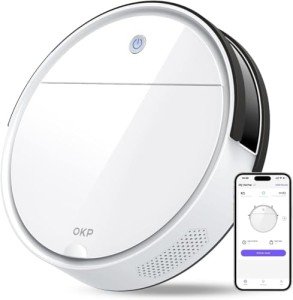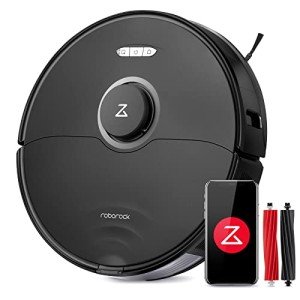This company has no active jobs
0 Review
Rate This Company ( No reviews yet )
About Us
The 10 Most Dismal Robot Vacuum Cleaner Errors Of All Time Could Have Been Prevented
The Unsung Hero of Modern Homes: Exploring the World of Robot Vacuum Cleaners
In today’s hectic world, where time is a valuable commodity, the need for smart home devices that simplify day-to-day chores is ever-increasing. Amongst these ingenious gadgets, the robot vacuum cleaner stands apart as a particularly important addition to any household. These compact and smart devices have actually reinvented the method we approach floor cleaning, offering benefit and effectiveness that was as soon as inconceivable. No longer relegated to futuristic fantasies, robot vacuum are now mainstream, continuously evolving with enhanced functions and capabilities, solidifying their location as an unsung hero of modern home upkeep.
This short article explores the fascinating world of robot vacuum cleaners, exploring their inner functions, the diverse types offered, their myriad benefits, and what to think about when choosing the ideal robotic cleaning companion for your home.
Deciphering the Technology: How Robot Vacuums Operate
Behind their unassuming outside lies a complex network of sensors, algorithms, and mechanical elements that make it possible for robot vacuum to autonomously navigate and clean your floorings. Comprehending the core technologies at play provides a much deeper gratitude for these smart devices:
1. Navigation and Mapping:
-
Sensors: Robot vacuums are equipped with a variety of sensors, including:
- Bump Sensors: These find physical barriers, allowing the robot to change direction upon crash.
- Cliff Sensors: Located on the bottom, these infrared sensing units prevent the robot from dropping stairs or ledges by finding abrupt drops.
- Wall Sensors: These help the robot follow walls and edges for comprehensive cleaning along boundaries.
- Optical or Visual Sensors: More innovative designs use cameras and visual mapping technology (SLAM – Simultaneous Localization and Mapping) to produce a detailed map of the home. This permits more systematic cleaning patterns and targeted room cleaning.
- Gyroscope and Accelerometer: These help track the robot’s movement and orientation, aiding in effective navigation.
-
Navigation Algorithms: Based on sensing unit information, sophisticated algorithms assist the robot’s cleaning path. Common navigation patterns include:
- Random Bounce: Simple models use a random pattern, bouncing off challenges till the area is covered– although less efficient, it still cleans.
- Spiral Cleaning: The robot relocates progressively larger spirals to clean a concentrated area.
- Edge Cleaning: The robot follows the perimeter of the room to make sure edges and corners are resolved.
- Methodical Cleaning (Zig-Zag, Row-by-Row): Advanced designs with mapping capabilities tidy in organized lines, making the most of coverage and performance.
2. Cleaning Mechanisms:
-
Brushes: Most robot vacuums utilize a combination of brushes to loosen and lift dirt and particles.
- Main Brush (Roller Brush): Located below, this turning brush agitates carpets and sweeps debris towards the suction inlet. Bristles are typically created for different floor types.
- Side Brushes: Extending out from the side of the robot, these small brushes sweep debris from edges and corners towards the main brush.
-
Suction Power: A motor produces suction to draw dust and particles into the dustbin. Suction power differs between designs, impacting their efficiency on various floor types and with various kinds of debris, like pet hair.
-
Dustbin: Collected dirt and debris are stored in an internal dustbin. Capability varies, and some designs use self-emptying functions where the dustbin is automatically emptied into a bigger base station.
A Spectrum of Choices: Types of Robot Vacuum Cleaners
The robot vacuum market varies, providing models tailored to different requirements and spending plans. Here are some crucial classifications:
-
Basic Robot Vacuums: These are typically economical and offer basic cleaning functions like random navigation, basic brushes, and dust collection. They are ideal for smaller areas and lighter cleaning requirements.
-
Smart Mapping Robot Vacuums: Equipped with visual or LiDAR (Light Detection and Ranging) mapping, these designs develop detailed maps of your home. This allows features like:
- Room-by-Room Cleaning: You can designate particular rooms to be cleaned.
- No-Go Zones: Establish virtual limits to avoid the robot from getting in certain areas.
- Custom Cleaning Schedules: Set cleaning schedules for specific spaces or zones at different times.
-
Robot Vacuum Mops: Many contemporary robot vacuums integrate mopping performance. These normally have a water tank and a mopping pad that damp-wipes hard floorings after vacuuming or as a standalone mopping cycle. Some advanced designs can separate between vacuuming and mopping modes effectively.
-
Self-Emptying Robot Vacuums: For supreme benefit, self-emptying models immediately move gathered particles from the robot’s dustbin into a bigger dust bag or bin within a docking station. This significantly minimizes the frequency of manual dustbin emptying.
-
Pet-Friendly Robot Vacuums: Designed specifically to take on pet hair, these models often feature more powerful suction, tangle-free brush styles, and bigger dustbins to handle the needs of pet-owning homes.
Unlocking the Benefits: Why Choose a Robot Vacuum?
The appeal of robot vacuum cleaners extends beyond their novelty. They use tangible advantages that streamline home cleaning and improve quality of life:
-
Convenience and Time-Saving: The most substantial advantage is the automated cleaning. Robot vacuums easily manage daily floor cleaning, releasing up your time for other tasks or just relaxation. Set a schedule, and they work while you are at work, running errands, or enjoying your free time.
-
Consistent Cleaning: Robot vacuums can be set to clean frequently, keeping a regularly cleaner home. Regular, light cleaning is typically more effective at preventing dirt and dust accumulation than irregular, deep cleans.
-
Enhanced Indoor Air Quality: Many robot vacuums are geared up with HEPA filters that trap fine dust particles, irritants, and pet dander. Regular use can add to improved indoor air quality, particularly helpful for allergy sufferers.
-
Reaching Under Furniture: Their low profile allows robot vacuums to navigate under beds, couches, and other furnishings, locations often missed by standard vacuums. This guarantees thorough cleaning in hard-to-reach areas.
-
Lowered Effort and Strain: For people with movement concerns, pain in the back, or busy lifestyles, robot vacuums remove the physical strain and effort related to manual vacuuming.
-
Smart Home Integration: Many designs incorporate with smart home environments, permitting control through smartphone apps, voice assistants (like Alexa or Google Assistant), and custom automation routines.
Browsing the Purchase: Choosing the Right Robot Vacuum for You
Picking the perfect robot vacuum needs mindful factor to consider of your specific needs and home environment. Here are essential aspects to assess:
-
Home Size and sma Layout: Larger homes or multi-story homes may take advantage of models with longer battery life and smart mapping for efficient coverage. Complex designs with numerous barriers might necessitate advanced navigation functions.
-
Floor Types: Consider the dominant floor enters your home. For primarily tough floorings, a basic design with excellent suction and mopping capabilities may suffice. Residences with carpets and carpets will require models with stronger suction and brush designs reliable on carpets.
-
Pet Ownership: If you have animals, focus on pet-friendly designs with strong suction, tangle-free brushes, and larger dustbins to manage pet hair effectively. HEPA purification is also highly advantageous for pet allergies.

-
Spending plan: Robot vacuum rates differ widely. Determine your budget and focus on functions that are essential to you. Fundamental designs offer vital cleaning at lower price points, while advanced features featured higher expenses.
-
Smart Features: Evaluate the worth of smart features like mapping, room choice, no-go zones, app control, and voice assistant integration based upon your tech savviness and desired level of control.
-
Battery Life and Charging Time: Ensure the battery life is adequate to clean your home on a single charge. Consider the charging time also.
-
Maintenance Requirements: Research the ease of dustbin emptying, brush cleaning, and filter replacement for different models. Self-emptying designs decrease maintenance frequency, however might have greater in advance expenses.
-
Sound Level: Robot vacuum noise levels differ. If noise sensitivity is a concern, examine the decibel score of various designs.
In summary, when selecting a robot vacuum, think about these elements:
Factors to Consider When Buying a Robot Vacuum Cleaner:
- Home Size and Layout
- Floor Types (Hardwood, Carpet, Tile)
- Presence of Pets
- Spending plan
- Preferred Smart Features (Mapping, App Control, Voice Integration)
- Battery Life and Charging Time
- Maintenance Requirements (Dustbin Capacity, Brush Cleaning)
- Noise Level
Keeping it Clean: Maintaining Your Robot Vacuum
Like any home appliance, appropriate upkeep is vital to ensure your robot vacuum operates effectively and delights in a long lifespan. Routine maintenance generally includes:
Robot Vacuum Maintenance Tips:
- Empty the Dustbin Regularly: Empty the dustbin after each cleaning cycle or as often as needed, specifically if you have animals or generate a great deal of dust.
- Clean the Brushes: Regularly eliminate and clean the main brush and side brushes. Hair and debris can tangle around the brushes, reducing their efficiency. Some brushes are developed to be tangle-free, but still require routine cleaning.
- Tidy or Replace Filters: Clean or change filters according to the manufacturer’s suggestions. This keeps suction power and makes sure reliable purification.
- Wipe Sensors: Gently wipe sensors with a dry cloth to get rid of dust and debris. Tidy sensing units are vital for accurate navigation.
- Inspect Wheels and Casters: Ensure wheels and casters are without particles and rotate efficiently.
- Maintain Mopping Pads (if appropriate): Wash or change mopping pads as directed to maintain hygiene and cleaning efficiency.
- Update Firmware (if applicable): For smart designs, keep the firmware updated to take advantage of efficiency enhancements and new features.
Acknowledging Limitations: Potential Drawbacks
While robot vacuum offer numerous benefits, it’s crucial to acknowledge their constraints:
- Corner and Edge Cleaning: While side brushes help, robot vacuums can often struggle to completely tidy corners and edges, particularly in intricate room layouts. Occasional manual edge cleaning may still be required.
- Barrier Navigation: Low-lying cords, small objects on the floor, and thick, shaggy carpets can sometimes posture obstacles. Cord management and pre-cleaning mess is often essential.
- Stairs (in most cases): Most robot vacuums can not climb stairs, requiring manual carrying for multi-level homes unless you have a devoted robot for each floor.
- Preliminary Cost: The in advance expense of a robot vacuum can be higher than conventional vacuums, specifically for innovative designs with mapping and self-emptying functions.
- Deep Cleaning Power: While excellent for keeping cleanliness, robot vacuums may not have the deep cleaning power of a full-size upright vacuum for greatly stained locations or deep pile carpets.
The Future is Autonomous: The Evolution of Robot Vacuums
The technology behind robot vacuum cleaners continues to advance quickly. Future trends consist of:
- Improved AI and Navigation: Expect a lot more advanced AI-powered navigation with better things recognition, barrier avoidance, and individualized cleaning regimens.
- Improved Cleaning Performance: Developments in brush designs, suction technology, and mopping systems will result in even more reliable cleaning throughout diverse floor types.
- Integration with Smart Home Ecosystems: Seamless combination with more comprehensive smart home platforms and communities will further enhance automation and control.
- More Affordable Advanced Features: As technology matures, advanced functions like mapping and self-emptying are most likely to end up being more accessible at lower cost points.
- Specialized Robots: We might see more specific robot vacuums developed for specific jobs, such as window cleaning or furniture cleaning.
Conclusion: Embracing the Robotic Cleaning Revolution
Robot vacuum cleaners have actually unquestionably changed home cleaning, offering a mix of benefit, performance, and smart innovation that aligns completely with modern-day lifestyles. While not a total replacement for all cleaning jobs, they are vital tools for maintaining tidy floorings with minimal effort. By understanding their abilities, types, and upkeep requirements, you can pick the perfect robot vacuum to become your silent cleaning partner, maximizing your time and contributing to a cleaner, much healthier home environment. Welcome the robotic cleaning revolution and experience the simple and easy cleanliness they bring.
Regularly Asked Questions (FAQs) about Robot Vacuum Cleaners
Q: Are robot vacuum reliable at cleaning?A: Yes, robot vacuums are reliable for daily maintenance cleaning, removing dust, dirt, and pet hair from floorings. Advanced designs with strong suction and mapping are particularly efficient. While they may not have the power of a full-size vacuum for deep cleaning heavily stained locations, they are exceptional for consistent maintenance.
Q: How long do robot vacuum batteries last?A: Battery life varies between models, normally ranging from 60 to 120 minutes on a single charge. Advanced models typically have longer run times. Some designs likewise use recharge and resume functions, returning to the charging dock and after that continuing cleaning from where they ended.
Q: Are robot vacuums noisy?A: Robot vacuum sound levels differ. Some fundamental designs can be fairly peaceful, while those with more powerful suction motors may be louder, but generally still quieter than traditional vacuums. Sound levels are normally comparable to a low discussion or a running dishwashing machine.
Q: Can robot vacuums deal with pet hair?A: Many robot vacuums are specifically designed for pet hair. Look for designs advertised as pet-friendly, which usually include stronger suction, tangle-free brushes, and larger dustbins to manage pet hair efficiently. HEPA filters are also helpful for pet allergic reaction sufferers.
Q: Can robot vacuums tidy carpets?A: Yes, lots of robot vacuums can clean carpets, particularly low-pile carpets and rugs. Designs with stronger suction and brush styles optimized for carpets are more efficient. Nevertheless, for deep cleaning high-pile carpets, a traditional upright vacuum might still be necessary.
Q: Do robot vacuums require a lot of upkeep?A: Robot vacuums require some maintenance, but it is usually straightforward. Routine jobs consist of emptying the dustbin, cleaning brushes, and changing filters. Self-emptying designs substantially lower the frequency of dustbin emptying.
Q: What is the lifespan of a robot vacuum cleaner?A: The life-span of a robot vacuum cleaner can differ depending on usage, upkeep, and model quality. With appropriate care and upkeep, a great quality robot vacuum can last for a number of years (typically 3-5 years or more).
Q: Are robot vacuums worth the investment?A: For lots of people, robot vacuums are a worthwhile investment due to the convenience, time-saving benefits, and constant cleaning they provide. The value proposal depends on specific requirements, way of life, and determination to purchase automated cleaning options.




